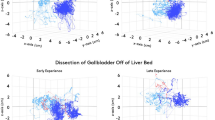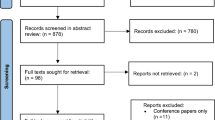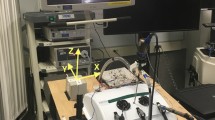Abstract
Background
Current evaluation methods for robotic-assisted surgery (ARCS or GEARS) are limited to 5-point Likert scales which are inherently time-consuming and require a degree of subjective scoring. In this study, we demonstrate a method to break down complex robotic surgical procedures using a combination of an objective cumulative sum (CUSUM) analysis and kinematics data obtained from the da Vinci® Surgical System to evaluate the performance of novice robotic surgeons.
Methods
Two HPB fellows performed 40 robotic-assisted hepaticojejunostomy reconstructions to model a portion of a Whipple procedure. Kinematics data from the da Vinci® system was recorded using the dV Logger® while CUSUM analyses were performed for each procedural step. Each kinematic variable was modeled using machine learning to reflect the fellows’ learning curves for each task. Statistically significant kinematics variables were then combined into a single formula to create the operative robotic index (ORI).
Results
The inflection points of our overall CUSUM analysis showed improvement in technical performance beginning at trial 16. The derived ORI model showed a strong fit to our observed kinematics data (R2 = 0.796) with an ability to distinguish between novice and intermediate robotic performance with 89.3% overall accuracy.
Conclusions
In this study, we demonstrate a novel approach to objectively break down novice performance on the da Vinci® Surgical System. We identified kinematics variables associated with improved overall technical performance to create an objective ORI. This approach to robotic operative evaluation demonstrates a valuable method to break down complex surgical procedures in an objective, stepwise fashion. Continued research into objective methods of evaluation for robotic surgery will be invaluable for future training and clinical implementation of the robotic platform.




Similar content being viewed by others
References
Saini V, Brownlee S, Elshaug AG, Glasziou P, Heath I (2017) Addressing overuse and underuse around the world. Lancet 390(10090):105–107. https://doi.org/10.1016/s0140-6736(16)32573-9
Vonlanthen R et al (2011) The impact of complications on costs of major surgical procedures: a cost analysis of 1200 patients. Ann Surg 254(6):907–913. https://doi.org/10.1097/SLA.0b013e31821d4a43
Khuri SF, Henderson WG, DePalma RG, Mosca C, Healey NA, Kumbhani DJ (2005) Determinants of long-term survival after major surgery and the adverse effect of postoperative complications. Ann Surg 242(3):326–341
Birkmeyer JD et al (2013) Surgical skill and complication rates after bariatric surgery. N Engl J Med 369(15):1434–1442. https://doi.org/10.1056/NEJMsa1300625
Hogg ME et al (2016) Grading of surgeon technical performance predicts postoperative pancreatic fistula for pancreaticoduodenectomy independent of patient-related variables. Ann Surg 264(3):482–491. https://doi.org/10.1097/sla.0000000000001862
Liu M, Purohit S, Mazanetz J, Allen W, Kreaden US, Curet M (2017) Assessment of robotic console skills (ARCS): construct validity of a novel global rating scale for technical skills in robotically assisted surgery. Surg Endosc. https://doi.org/10.1007/s00464-017-5694-7
Goh AC, Goldfarb DW, Sander JC, Miles BJ, Dunkin BJ (2012) Global evaluative assessment of robotic skills: validation of a clinical assessment tool to measure robotic surgical skills. J Urol 187(1):247–252. https://doi.org/10.1016/j.juro.2011.09.032
Deal SB et al (2017) Evaluation of crowd-sourced assessment of the critical view of safety in laparoscopic cholecystectomy. Surg Endosc 31(12):5094–5100. https://doi.org/10.1007/s00464-017-5574-1
Gao Y, et al (2014) JHU-ISI gesture and skill assessment working set (JIGSAWS): a surgical activity dataset for human motion modeling. In: MICCAI Workshop: M2CAI, 2014, vol 3
Jog A, Itkowitz B, Liu M, DiMaio S, Hager G (2011) Towards integrating task information in skills assessment for dexterous tasks in surgery and simulation. In: 2011 IEEE International Conference on Robotics and Automation (pp. 5273–5278)
Wohl H (1977) The cusum plot: its utility in the analysis of clinical data. N Engl J Med 296(18):1044–1045. https://doi.org/10.1056/nejm197705052961806
Chaput de Saintonge DM, Vere DW (1974) Why don't doctors use cusums? Lancet 1(7848):120–121
Cavill I (1971) Quality control in routine haemoglobinometry. J Clin Pathol 24(8):701–704
Bosker R, Groen H, Hoff C, Totte E, Ploeg R, Pierie JP (2013) Early learning effect of residents for laparoscopic sigmoid resection. J Surg Educ 70(2):200–205. https://doi.org/10.1016/j.jsurg.2012.10.004
Mackenzie H et al (2013) Clinical and educational proficiency gain of supervised laparoscopic colorectal surgical trainees. Surg Endosc 27(8):2704–2711. https://doi.org/10.1007/s00464-013-2806-x
Guend H et al (2017) Developing a robotic colorectal cancer surgery program: understanding institutional and individual learning curves. Surg Endosc 31(7):2820–2828. https://doi.org/10.1007/s00464-016-5292-0
Zhang L et al (2013) Characterizing the learning curve of the VBLaST-PT((c)) (Virtual Basic Laparoscopic Skill Trainer). Surg Endosc 27(10):3603–3615. https://doi.org/10.1007/s00464-013-2932-5
De Gori M, Adamczewski B, Jenny JY (2017) Value of the cumulative sum test for the assessment of a learning curve: application to the introduction of patient-specific instrumentation for total knee arthroplasty in an academic department. Knee 24(3):615–621. https://doi.org/10.1016/j.knee.2017.03.007
Tam V et al (2017) Robotic pancreatoduodenectomy biotissue curriculum has validity and improves technical performance for surgical oncology fellows. J Surg Educ. https://doi.org/10.1016/j.jsurg.2017.05.016
Yap CH, Colson ME, Watters DA (2007) Cumulative sum techniques for surgeons: a brief review. ANZ J Surg 77(7):583–586. https://doi.org/10.1111/j.1445-2197.2007.04155.x
Kestin IG (1995) A statistical approach to measuring the competence of anaesthetic trainees at practical procedures. Br J Anaesth 75(6):805–809
Hung AJ, Chen J, Gill IS (2018) Automated performance metrics and machine learning algorithms to measure surgeon performance and anticipate clinical outcomes in robotic surgery. JAMA Surg. https://doi.org/10.1001/jamasurg.2018.1512
Hanzly MI et al (2015) Simulation-based training in robot-assisted surgery: current evidence of value and potential trends for the future. Curr Urol Rep 16(6):41. https://doi.org/10.1007/s11934-015-0508-8
Hogg ME et al (2017) Mastery-based virtual reality robotic simulation curriculum: the first step toward operative robotic proficiency. J Surg Educ 74(3):477–485. https://doi.org/10.1016/j.jsurg.2016.10.015
Newcomb LK et al (2017) Correlation of virtual reality simulation and dry lab robotic technical skills. J Minim Invasive Gynecol. https://doi.org/10.1016/j.jmig.2017.11.006
Tam V, Zeh HJ 3rd, Hogg ME (2017) Incorporating metrics of surgical proficiency into credentialing and privileging pathways. JAMA Surg 152(5):494–495. https://doi.org/10.1001/jamasurg.2017.0025
Funding
Hardware (dV Logger®) and kinematics data supplied by Intuitive Surgical®. Subsequent ongoing related studies funded by Intuitive Surgical®.
Author information
Authors and Affiliations
Corresponding author
Ethics declarations
Disclosures
The “Black Box” or dV Logger® and kinematics data from the dV Logger® was supplied by Intuitive Surgical®. Dr. Lyman reports nonfinancial support from Intuitive Surgical, during the conduct of the study; grants from Intuitive Surgical, outside the submitted work. Dr. Khan reports personal fees from Intuitive Surgical, outside the submitted work; Dr. Martinie reports grants, personal fees and nonfinancial support from Intuitive Surgical, outside the submitted work; Dr. Vrochides reports nonfinancial support from Intuitive Surgical, during the conduct of the study; grants and nonfinancial support from Intuitive Surgical, outside the submitted work. Dr. Passeri, Mr. Murphy, Dr. Siddiqui, Dr. Iannitti, Dr. Baker have nothing to disclose.
Additional information
Publisher's Note
Springer Nature remains neutral with regard to jurisdictional claims in published maps and institutional affiliations.
Electronic supplementary material
Below is the link to the electronic supplementary material.
Supplementary file1 (AVI 135451 kb)
Rights and permissions
About this article
Cite this article
Lyman, W.B., Passeri, M.J., Murphy, K. et al. An objective approach to evaluate novice robotic surgeons using a combination of kinematics and stepwise cumulative sum (CUSUM) analyses. Surg Endosc 35, 2765–2772 (2021). https://doi.org/10.1007/s00464-020-07708-z
Received:
Accepted:
Published:
Issue Date:
DOI: https://doi.org/10.1007/s00464-020-07708-z




